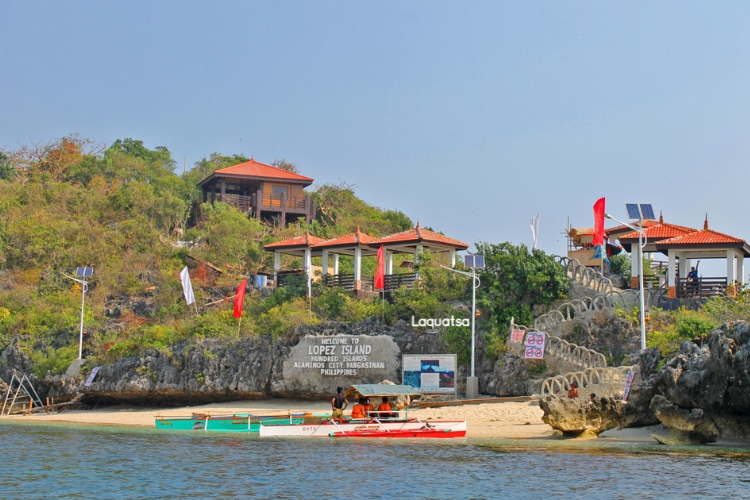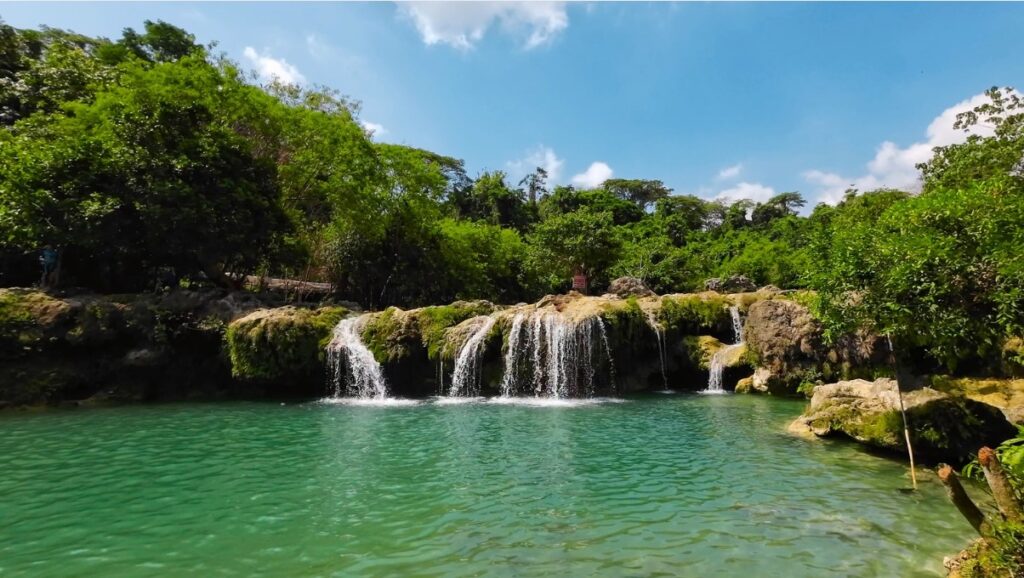It’s been a full decade since I last set foot in Hundred Islands National Park, and I can honestly say—it still holds the same magic, but with a lot more in store.
Located in Alaminos, Pangasinan, this cluster of 124 islands (123 during high tide) is one of the Philippines’ most iconic destinations. Whether you’re after scenic views, beach lounging, or cliff diving adventures, this place offers something for everyone.
We first explored Hundred Islands 10 years ago with friends. This time, we brought the whole family for a fresh adventure and I wanted to share what’s new, what to prepare for, and some honest notes if you’re planning to go soon, especially if it’s been a while since your last visit.
📋 Hundred Islands Entrance Fees 2025
Day Tour: ₱120 per person
- Environmental Fee: ₱80
- Entrance Fee: ₱30
- Insurance/Coverage Fee: ₱10
Overnight: ₱200 per person
- Environmental Fee: ₱160
- Entrance Fee: ₱30
- Insurance/Coverage Fee: ₱10
🏝️ A Little Background
Hundred Islands is the first national park in the Philippines, established in 1940. Most of the islands remain untouched, but a few have been developed for tourism, including:
- Governor’s Island – Famous for its scenic view deck and zipline that connects to Virgin Island.
- Ramos Island – Known for its peaceful bonsai garden
- Sandal Island (Helipad) – Breezy and open, with a helipad and panoramic sea views.
- Quezon Island – The most developed island, with swimming areas, food stalls, ziplines, and cottages.
- Children’s Island – Shallow waters and picnic huts make it perfect for families with young kids.
- Pilgrimage Island – Features a towering Christ the Savior statue and a path for the Stations of the Cross.
- Marcos Island – Popular for Imelda Cave, where you can cliff-jump into a natural sea pool.
- Lopez Island – Peaceful and quiet, great for laid-back swimming or sunbathing.
- Romulo Island – Less crowded, ideal for short stops, quick dips, or a quiet lunch.
- Cuenco Island – Unique for its cave tunnel that runs completely through the island.
- Scout Island – A quiet picnic spot, often used for lunch breaks
- Cathedral Island – Sightseeing only; named for its cathedral-like rock formations.
- Macapagal Island (Devil’s Island) – Despite the name, it’s calm and scenic with decent snorkeling spots.
- Mayor’s Island – Often reserved for private groups or exclusive rentals.
- Virgin Island – Once avoided due to sea snakes (now gone)
- Turtle Island – Shaped like a turtle
- Bat Island – Home to hundreds of fruit bats hanging from trees and cliffs.
Each one offers a different vibe—from family-friendly shores to cliff-diving spots and quiet picnic corners.
What’s New?
The biggest change we noticed was Pilgrimage Island—once called Martha Island—now beautifully enhanced and interconnected with Ramos Island and Sandal Island. Ramos is connected to Pilgrimage via a natural sandbar, while a floating bridge—made of container platforms—links Ramos to Sandal. There were no attractions like this back then.
Pilgrimage Island now features two accessible walking paths: one longer route for quiet reflection, and one shorter trail that makes it easier for tourists to reach the summit faster. With over a thousands steps leading up to the Christ the Savior statue and Stations of the Cross, it has also become a go-to destination for faith tourism, especially during Holy Week.
Ramos Island on the other hand features a tranquil bonsai garden—perfect for plant titos and titas—while Sandal Island offers a breezy helipad area, ideal for panoramic views with the statue as your backdrop.
🏖️Private Island Rentals in Hundred Islands?
Looking for total privacy? You can now rent an entire island for your group—either for a day tour or overnight stay. Rates vary depending on the island:
- Quezon Island – ₱100,000 (day) / ₱150,000 (overnight)
- Governor’s Island – ₱80,000 / ₱100,000
- Children’s Island – ₱80,000 / ₱100,000
- Pilgrimage Island – ₱100,000 / ₱150,000
- Other smaller islands – ₱20,000 / ₱25,000
It’s definitely a splurge—but for big groups or special occasions, having your own island might just be the most unforgettable way to experience Hundred Islands.
Life Vest Policy (Updated)
The life vest is included with the boat, but you’re not allowed to use it for swimming. It’s for boat safety only. If you want to wear one while swimming or snorkeling, you’ll need to rent a separate vest for ₱50. It’s a small fee, but the rule was unexpected, and the vests felt flimsier compared to before.
🚤The Hundred Islands Boat Tour
Exploring the Hundred Islands starts with a boat—and it’s still the best way to see the park’s most iconic spots. The tour is simple and well-managed, but knowing what to expect (and what to ask for) can make your experience a lot smoother.
How the Tour Works
After registering at the tourism office, you’ll be assigned a boat depending on your group size. Tourists are usually taken to 3–6 islands unless you request specific stops. Some of the most visited islands include:
- Pilgrimage Island – Now interconnected with Ramos Island (home to a Bonsai Garden) and Sandal Island, which features a scenic helipad viewpoint
- Quezon Island – Most developed, with food, ziplines, and swimming spots
- Children’s Island – Calm waters for families
- Marcos Island – Features Imelda Cave where you can cliff dive into a hidden sea pool
- Cuenco Cave – A tunnel cave with a scenic walking path and an alternative cliff diving spot if Marcos Island isn’t available
Some boatmen will follow the default route, so if you’re hoping to visit quieter spots or spend more time on a particular island, make sure to mention it before departure.
Current Rates and Fees (as of 2025)
- Boat Rental:
- Small (1–5 pax): ₱1,400
- Medium (6–10 pax): ₱1,800
- Large (11–15 pax): ₱2,000
Every boat includes basic life vests, though they’re for boat use only—not for swimming.
Accommodations: Then vs. Now
Back then, we were younger and more adventurous—so camping with tents right on the beach sounded like a great idea. We even roasted pineapples by the shore (they tasted better than expected!). But this time, traveling with our senior parents meant comfort was the priority.
We stayed at Island Tropic, just a short walk from the registration area. It had a pool, a restaurant, and a menu we genuinely loved. Budget accommodations like this start at around ₱1,500 per night.
For those looking to splurge, you can even rent an island or stay in on-island accommodations, which are listed online for around ₱5,000—but we were quoted ₱10,000 during our visit. Best to confirm with the Alaminos Tourism Office to avoid surprises.
Bilao Tip: Buy Local!
Once you reach the boating section, a coordinator will usually approach your group and offer seafood bilaos—ready-to-eat and perfect to bring on your island tour. Earlier that day, we were impatient and tried to find where we can buy one—but we couldn’t find any. We ended up buying regular ulam instead, which turned out to be quite pricey for what we got.
If you didn’t bring anything, don’t worry—be confident that someone will offer you one at the dock. It’s fresh, convenient, and supports local boatmen and their families.
Optional Add-Ons (If You Have Time)
We didn’t try any activities this time due to the heat and limited time, but here’s what’s available:
- 🎯 Zipline – ₱100–₱250
- 🛶 Kayak Rental – ₱250/hour
- 🍌 Banana Boat Ride – ₱1,500
- 🤿 Helmet Diving – ₱400
- 🥽 Snorkeling Gear – ₱250
We’re saving the zipline and helmet diving for our next trip—hopefully during cooler months.
🍧Island Finds: Halo-Halo Everywhere!
One surprise we loved? Halo-halo is sold on almost every island! Vendors on boats or stalls offer it cold and sweet—perfect after a swim. Don’t miss it!
If you bring snacks or drinks, make sure to take your trash with you. There are some bins, but better to be a responsible traveler. 🌿
☀️ Final Thoughts (And a Tip for Next Time)
Hundred Islands is still worth visiting, but be ready for the summer crowd and heat. Quezon Island gets packed quickly. Next time, we’ll go during the cooler months to fully enjoy the vibe and try the activities.
Despite a few minor downsides—extra fees, vest rules, and summer rush—it’s organized, beautiful, and memorable. Pack smart, go early, and enjoy the experience. 💙
❓ Frequently Asked Questions
How many islands are open to tourists in Hundred Islands?
While there are 124 islands at low tide, only about 10–14 are developed for tourism. The most commonly visited are Governor’s Island, Quezon Island, Children’s Island, and Pilgrimage Island.
What is the best time to visit Hundred Islands?
It depends! Summer is sunny but hot and crowded. Cooler months (like November to February) offer a more relaxed vibe.
Can you do a Hundred Islands day tour from Manila?
Yes! It’s about a 5–6 hour drive from Manila. Many tour operators offer day trips, but an overnight stay allows you to see more.
Is there food available on the islands?
Yes, especially on Quezon and Pilgrimage Island. Plus, you’ll find seafood bilaos and halo-halo—just be ready with cash.
Do you need to book a tour in advance?
Not necessarily. You can walk in and book directly at the tourism office in Alaminos. But during peak season or holidays, better safe than sorry!
Are the Hundred Islands family-friendly?
Very much so! Children’s Island is especially safe for kids. Just plan ahead if traveling with seniors or toddlers.


